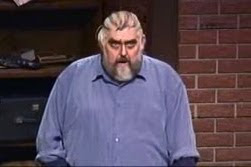
THEATRE REVIEW:
AFTER AKHMATOVA
30 MAR/11
JOHN COULBOURN,
QMI Agency
Rating: 4 out of 5
In a world obsessed with celebrity, it grows increasingly difficult sometimes to separate art from artist -- the life the artist lives from the art he makes. That's the very conflict that sits at the centre of AFTER AKHMATOVA, a challenging and thought-provoking new play from Kate Cayley that premièred Wednesday on the stage of the Tarragon Extra Space.
If the name Akhmatova doesn't ring a bell, small wonder. In a time when poetry is held in ever-more-diminished regard, there is every chance you've never heard of a lot of 20th century Canadian poets (and yes, they do exist), and few would be expected to know of the the 20th century Russian poet Anna Akhmatova. Or of Requiem -- her poetic cri de coeur for a tortured nation, written under the very noses of Stalin and his brutal henchmen, all of whom only ever saw the smoke of its burning after it was committed to memory. Requiem was not published until 1963.
Fittingly, the play begins just over two years after Akhmatova's death in 1966, after Alan Taylor -- an American historian played by Paul Dunn -- has made his way to Russia to interview Lev Gumilyov (Eric Goulem), Akhmatova's only son. But the Russian professor Taylor comes to interview is more than merely the son of the deceased poet, it develops. He is also the inspiration for her masterwork, all of which was written in the wake of his imprisonment for nebulous political crimes. What begins as an interview quickly becomes a confrontation, however, as the two principals struggle to create a portrait of the deceased poet that reflects each man's image of her.
As a fan, self-cast as a worshipful biographer, Taylor's vision of the late poet is shaped by the romantic notion that great art grows from great suffering, while Gumilyov's vision is informed more by recollections of an often absent parent who too often seemed to care more for her art than for her child. At the heart of both visions is Requiem -- a work of art that neither man seems quite capable of divorcing from the artist who created it.
Slowly, as they move often reluctantly through Gumilyov's memories of his mother (played by Sarah Orenstein) and the community that sustained her -- Richard McMillan is cast as the poet Osop Mandelstam, Caroline Gillis as his wife Nadezhda and Claire Calnan as Akhmatova's friend, Lydia Chukovskaya -- the two find common ground in the art the poet left behind.
It's a complex story and it is well brought to life by a powerful cast, used to maximum advantage by director Alan Dilworth, (who coincidentally was named as a new participant in the Stratford Festival's Michael Langham Workshop for Classical Direction on Thursday.)
Working with designers Jung-Hye Kim (set and costumes), Kimberly Purtell (Lighting) and Thomas Ryder Payne (sound), Dilworth and his cast conspire to overlay the entire production with an unmistakable aura of Russian mystery and suffering, without resorting to accents, black bread or other clichés.
Best of all, more often than not they are equal to whatever complex challenges Cayley throws at them, in terms of time and character shifting. Goulem's Gumilyov often seems carved from a block of endless suffering, while McMillan gives a moving and uncharacteristically understated performance that meshes beautifully with fine work from Gillis, Calnan and Orenstein. Indeed, only Dunn seems out of his depth here, offering up a Taylor more driven by mannered ticks and earnestness than any true sense of romance -- an over-embroidered performance that robs the character of much of its dramatic arc, shortchanging the production in the process. Happily, there's enough left over to make this a memorable play.























